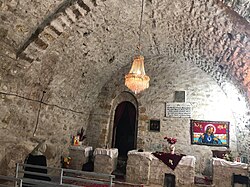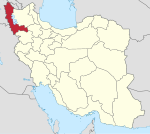Mavana
Village in West Azerbaijan province, Iran
Village in West Azerbaijan, Iran
Mavana Persian: موانا | |
|---|---|
Village | |
 Assyrian church of Mar Toma in Mavana | |
| 37°34′26″N 44°47′43″E / 37.57389°N 44.79528°E / 37.57389; 44.79528[1] | |
| Country | Iran |
| Province | West Azerbaijan |
| County | Urmia |
| District | Silvaneh |
| Rural District | Targavar |
| Population (2016)[2] | |
| • Total | 1,314 |
| Time zone | UTC+3:30 (IRST) |
Mavana (Persian: موانا)[a] is a village in, and the capital of, Targavar Rural District of Silvaneh District of Urmia County, West Azerbaijan province, Iran.[4]
Demographics
Language and ethnicity
While historically Assyrian, the village is populated by Herki Kurds today.[5][6]
Population
At the time of the 2006 National Census, the village's population was 1,134 in 179 households.[7] The following census in 2011 counted 1,114 people in 219 households.[8] The 2016 census measured the population of the village as 1,314 people in 275 households. It was the most populous village in its rural district.[2]
Gallery
-
 A Mawana Assyrian family making dairy product using sheepskin.
A Mawana Assyrian family making dairy product using sheepskin.
See also
 Iran portal
Iran portal
Notes
References
- ^ OpenStreetMap contributors (17 February 2024). "Mavana, Urmia County" (Map). OpenStreetMap (in Persian). Retrieved 17 February 2024.
- ^ a b "Census of the Islamic Republic of Iran, 1395 (2016)". AMAR (in Persian). The Statistical Center of Iran. p. 04. Archived from the original (Excel) on 30 August 2022. Retrieved 19 December 2022.
- ^ Mavana can be found at GEOnet Names Server, at this link, by opening the Advanced Search box, entering "-3074367" in the "Unique Feature Id" form, and clicking on "Search Database".
- ^ Mousavi, Mirhossein (2 February 1366). "Creation and formation of 20 rural districts including villages, farms and places in Urmia County under West Azerbaijan province". Islamic Parliament Research Center (in Persian). Ministry of Interior, Board of Ministers. Archived from the original on 23 April 2012. Retrieved 14 December 2023.
- ^ انزلى، حسن (2005). اورميه در گذر زمان (in Persian). p. 341.
- ^ "قالی های ایل هرکی ارومیه" (in Persian). Tehran Carpet Designers Association. Retrieved 30 April 2020.
- ^ "Census of the Islamic Republic of Iran, 1385 (2006)". AMAR (in Persian). The Statistical Center of Iran. p. 04. Archived from the original (Excel) on 20 September 2011. Retrieved 25 September 2022.
- ^ "Census of the Islamic Republic of Iran, 1390 (2011)". Syracuse University (in Persian). The Statistical Center of Iran. p. 04. Archived from the original (Excel) on 20 January 2023. Retrieved 19 December 2022.
- v
- t
- e
West Azerbaijan province, Iran

and cities
 | This Urmia County location article is a stub. You can help Wikipedia by expanding it. |
- v
- t
- e













